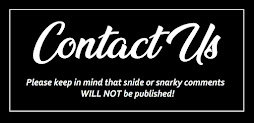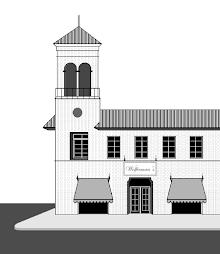South Independence Boulevard (Charlottetowne Avenue) / US 74 and South Kings Drive
Charlotte, North Carolina
The first fully-enclosed shopping center in the Southeast, and fourth major interior mall in the United States, was built by the Community Research & Development, Corporation. This was a subsidiary of Maryland's James W. Rouse Company.
CHARLOTTETOWN MALL was situated on 10 acres, which were part of a 26-acre parcel. This was located on the southeastern fringes of Charlotte's center city, or "Uptown," area. The site was part of the Thompson Orphanage and was leased from the Episcopal Church's North Carolina Diocese, who had operated the children's home.
Designed by Charlotte's A.G. Odell, Junior, the CHARLOTTETOWN project was the third mall-type retail complex built by the Rouse Company. An official dedication was held on October 28, 1959. James W. Rouse served as Master of Ceremonies. In attendance were Willard G. Rouse (brother of James W.), Herbert Hitch (Charlotte Mayor Pro Tem), M.D. Wisnant (Orphanage Superintendent) and other local dignitaries. A time capsule was buried (to be retrieved in October 1984). Entertainment was provided by the Davidson College Band.
CHARLOTTETOWN MALL encompassed approximately 250,000 leasable square feet and was anchored by a 2-level (40,000 square foot), Asheville-based Bon Marche department store (this North Carolina chain having no connection with the Seattle-based retailer of the same name).
Thirty-eight stores and services were situated around a 2-story Central Mall, which featured a Cascading Garden & fountain, Desert Garden, fish pond and three spaceship-shaped bird aviaries. These were populated with macaws, peach-faced parakeets and Australian finches. Lining the Central Mall were antique gas street lamps from Philadelphia.
Charter first floor stores included Eckerd Drugs, Western Auto, Lerner Shops, The Tweed Shop, Charlottetown Pet Center, a (30,000 square foot) Roses 5-10 & 25 Cent store, (20,300 square foot) Franklin Simon and (25,000 square foot) Colonial Stores supermarket. On the second floor were an S & W Cafeteria, Community Auditorium and 12,000 square feet of leased office spaces.
Originally, the CHARLOTTETOWN MALL structure was to have been the first phase of a two-phase development. A 6-acre tract north of the mall was to be utilized for a large department store, additional inline retail or motel. These would be connected with the existing mall via a pedestrian bridge over South Independence Boulevard. This never came to fruition.
The General Cinema Corporation Cinema I & II was eventually built on the north site. The venue opened on November 6, 1963 and was one of the nation's first twin cinema operations. Soon after the cinema's completion, the closing of the mall's The Bon Marche was announced. It went dark on January 11, 1964 and was proceeded by an Ivey's of Charlotte branch, which welcomed its first shoppers on February 20, 1964.
CHARLOTTETOWN MALL was successful throughout the 1960s. However, this began to change with the completion of SOUTHPARK (February 1970) and EASTLAND MALL (July 1975). Both complexes, built within 5 miles of CHARLOTTETOWN, encompassed around 1 million leasable square feet. In an attempt to revitalize their smaller, inner-city shopping hub, the Rouse Company decided to remarket it as a low-price-point retail venue.
The mall was given an indoor-outdoor refurbishment, envisaged by the Clark, Tribble, Harris & Li firm, of Charlotte. It re-opened, as OUTLET SQUARE, on October 15, 1981. Ivey's, who were being outpositioned by the outlet mall conversion, pulled up stakes in May 1981. Burlington Coat Factory opened in the vacant store space on September 11th of the same year.
Stores in the new OUTLET SQUARE included Dansk Factory Outlet, Plumm's Women's Fashions Discounter, Outlet Square Sewing Center, Crystal & Glass Outlet and Off The Rax. Tenants held over from the previous mall included Eckerd Drug, Gingiss Formal Wear, World Bazaar and Big Star Market (a January 1973 rebranding of the Colonial Stores grocery).
At first, the OUTLET SQUARE concept did well. The first harbinger of doom was when a second outlet-type mall opened in the vicinity. OUTLET MARKETPLACE {8 miles south, in York County, South Carolina} held its grand opening in April 1986.
OUTLET SQUARE was also stymied by construction of the John Belk Freeway / Interstate 277 Loop, in center city Charlotte. By the time the highway opened to traffic, in mid-1988, the Rouse company were in the process of converting OUTLET SQUARE back to a more traditional shopping mall.
On July 1, 1988, OUTLET SQUARE was officially renamed MIDTOWN SQUARE. Stores staying on through the conversion included Burlington Coat Factory, The Sock Market, Cress Jewelers, Eckerd Drug and Linens 'n Things. Harris Teeter was not along for the ride. Their store had opened, in the Big Star space, on March 29, 1984. It was shuttered on July 15, 1988.
An indoor-outdoor refurbishment of MIDTOWN SQUARE commenced in April 1989. As part of the 4 million dollar project, the exterior was refinished, ceilings raised and new lighting installed. The vacant Harris Teeter was divided into four sections, with one being used for a 2-bay expansion of the adjacent food court. Work wrapped up in early December.
The north site cinema, which had operated with three screens since May 1976, was shuttered in 1994. It would sit boarded up and abandoned for over 10 years. Across the boulevard, MIDTOWN SQUARE was gradually declining. A redevelopment plan began to surface in late 1999. The moribund mall and cinema would be demolished and replaced by CENTER CITY VILLAGE, a retail and residential complex.
Burlington Coat Factory closed for good in August 2001. Other MIDTOWN SQUARE tenants had closed by 2003. The impending redevelopment was delayed by the post-911 recession but had got back on track by the mid-2000s. Under a revised plan, THE METROPOLITAN and MIDTOWN CROSSING facilities would be developed by a joint venture of Charlotte-based Pappas Properties and Collette Associates and the Birmingham-based Colonial Properties Trust.
Demolition commenced in September 2005. MIDTOWN CROSSING, which encompassed 264,000 square feet, took the place of the cinema. It housed a (128,000 square foot) Home Depot Design Center on its first level and (136,000 square foot) Target on the second. An adjacent multi-level parking garage was included in the project. Target held its grand opening on October 14, 2007.
Across Independence Boulevard (which had been renamed Charlottetowne Avenue) was the 225 million dollar THE METROPOLITAN. This 412,200 square foot complex was built on the former mall site. Stores included a (30,000 square foot) Best Buy, (20,400 square foot) Staples and (32,900 square foot) Marshalls. Stores opened for business on August 7, 2008. A (12,900 square foot) Trader Joe's was dedicated on October 10th. THE METROPOLITAN also housed 170,400 square feet of office space and 101 luxury apartments.
The Home Depot Design Center at MIDTOWN CROSSING went dark in April 2009. It was replaced by a (100,000 square foot) B.J.'s Wholesale Club and (14,000 square foot) Petco. B.J.'s welcomed its first shoppers on November 14, 2015.
Sources:
The Charlotte Observer
Charlotte-Mecklenburg Historic Landmarks Commission
https://www.urbanplanet.org /North Carolina / Charlotte / "Uptown Living"
http://www.cinematreasures.org
http://www.therousecompany.com (Website on Internet Archive Wayback Machine)
Groceteria website "Charlotte: The 1960's" article / David Gwynn webmaster
http://www.pappasproperties.com / Pappas PropertiesColonial Properties Trust press release / October 3, 2005


